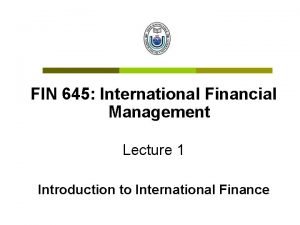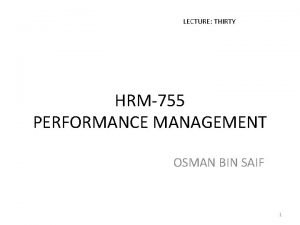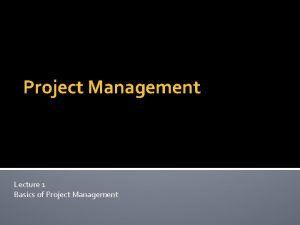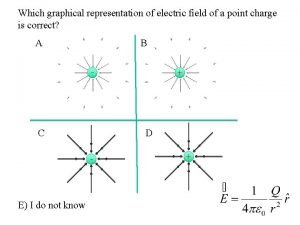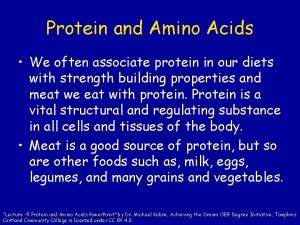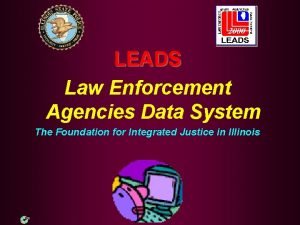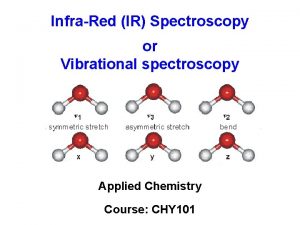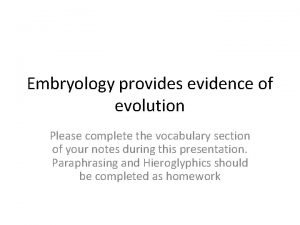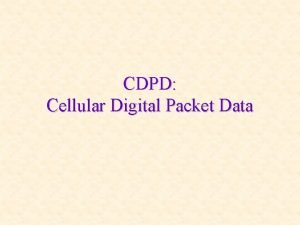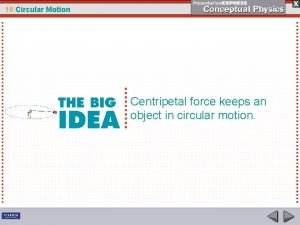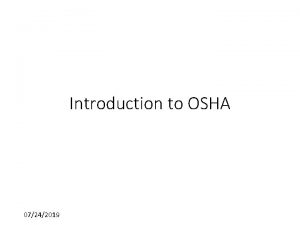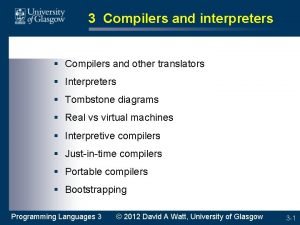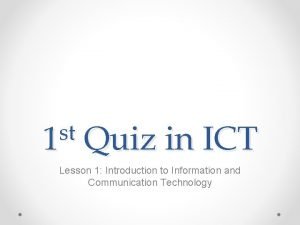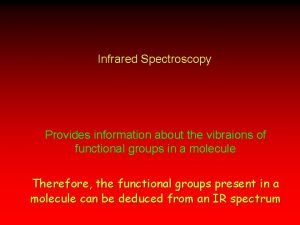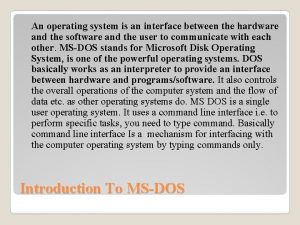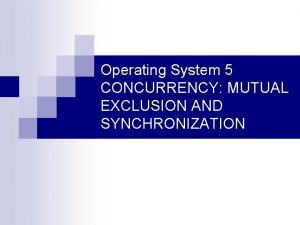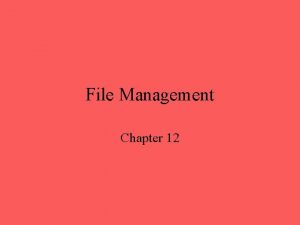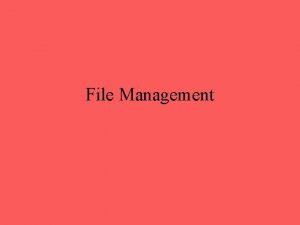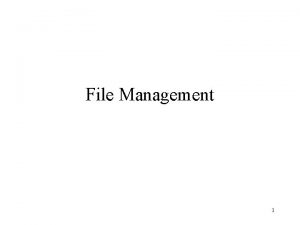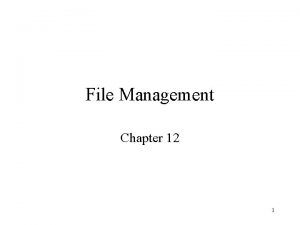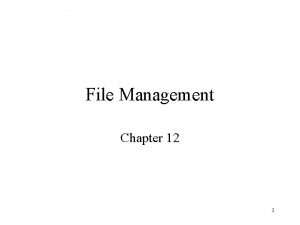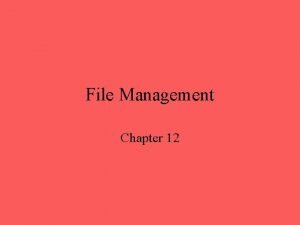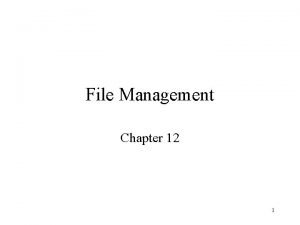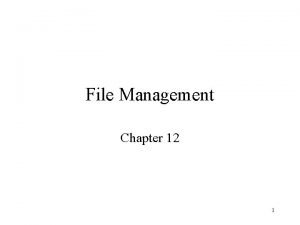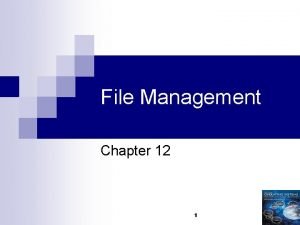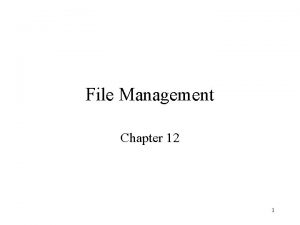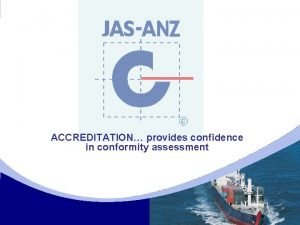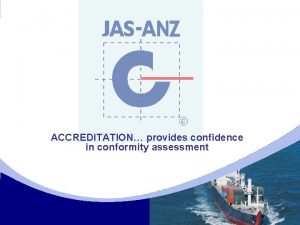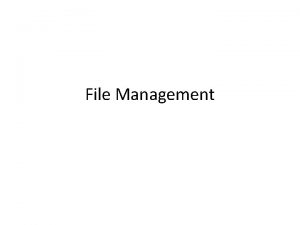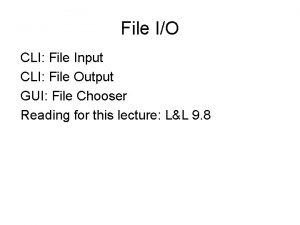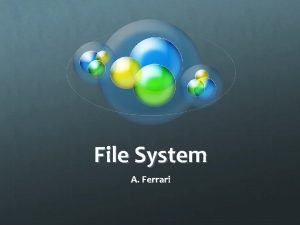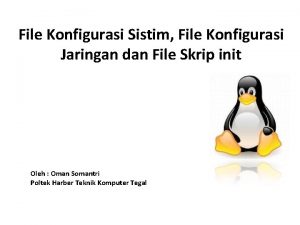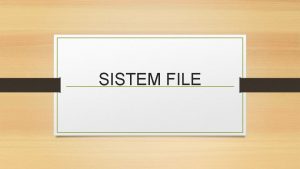Lecture 12 File Management File Management n provides






















































- Slides: 54

Lecture 12: File Management

File Management n provides the file abstraction for data storage n guarantees data validity (most of the time) n performance: throughput and response time n enforces protection Operating System Concepts – 7 th Edition, Jan 1, 2005 10. 2 Silberschatz, Galvin and Gagne © 2005

File-System Interface n File Concept n Access Methods n Directory Structure n File-System Mounting n File Sharing n Protection Operating System Concepts – 7 th Edition, Jan 1, 2005 10. 3 Silberschatz, Galvin and Gagne © 2005

File Concept n Contiguous logical address space n Persistent - stored on non-volatile memory (storage) n Identified by (external) name pathname in UNIX Operating System Concepts – 7 th Edition, Jan 1, 2005 10. 4 Silberschatz, Galvin and Gagne © 2005

File Structure n None - sequence of words, bytes n Simple record structure Lines Fixed length Variable length n Complex Structures Formatted document Relocatable load file n Can simulate last two with first method by inserting appropriate control characters n Who decides: Operating system Program Operating System Concepts – 7 th Edition, Jan 1, 2005 10. 5 Silberschatz, Galvin and Gagne © 2005

File Attributes n Name – only information kept in human-readable form n Identifier – unique tag (number) identifies file within file system n Type – needed for systems that support different types n Location – pointer to file location on device n Size – current file size n Protection – controls who can do reading, writing, executing n Time, date, and user identification – data for protection, security, and usage monitoring n Information about files are kept in the directory structure, which is maintained on the disk Operating System Concepts – 7 th Edition, Jan 1, 2005 10. 6 Silberschatz, Galvin and Gagne © 2005

File Operations n Create n Write n Read n Reposition within file n Delete n Truncate n Open(Fi) –open read/write session for Fi File pointer: pointer to last read/write location, n Close (Fi) – close read/write session Operating System Concepts – 7 th Edition, Jan 1, 2005 10. 7 Silberschatz, Galvin and Gagne © 2005

Access Methods Sequential Access read next write next reset no read after last write (rewrite) n Direct Access read n write n position to n read next write next rewrite n n = relative block number n Operating System Concepts – 7 th Edition, Jan 1, 2005 10. 8 Silberschatz, Galvin and Gagne © 2005

Directories n Set of files n Used to organize files n Translates external file names to internal file names (file labels, i- nodes, file control blocks) n Treated as a file but with special operations Operating System Concepts – 7 th Edition, Jan 1, 2005 10. 9 Silberschatz, Galvin and Gagne © 2005

Operations Performed on Directory n Search for a file n Create a file n Delete a file n List a directory n Rename a file n Traverse the file system Operating System Concepts – 7 th Edition, Jan 1, 2005 10. 10 Silberschatz, Galvin and Gagne © 2005

Organize the Directory (Logically) to Obtain n Efficiency – locating a file quickly n Naming – convenient to users Two users can have same name for different files The same file can have several different names n Grouping – logical grouping of files by properties, (e. g. , all Java programs, all games, …) Operating System Concepts – 7 th Edition, Jan 1, 2005 10. 11 Silberschatz, Galvin and Gagne © 2005

Single-Level Directory n A single directory for all users Naming problem Grouping problem Operating System Concepts – 7 th Edition, Jan 1, 2005 10. 12 Silberschatz, Galvin and Gagne © 2005

Two-Level Directory n Separate directory for each user n Path name n Can have the same file name for different user n Efficient searching n No grouping capability Operating System Concepts – 7 th Edition, Jan 1, 2005 10. 13 Silberschatz, Galvin and Gagne © 2005

Tree-Structured Directories Operating System Concepts – 7 th Edition, Jan 1, 2005 10. 14 Silberschatz, Galvin and Gagne © 2005

Tree-Structured Directories (Cont) n Efficient searching n Grouping Capability n Current directory (working directory) cd /spell/mail/prog type list Operating System Concepts – 7 th Edition, Jan 1, 2005 10. 15 Silberschatz, Galvin and Gagne © 2005

Tree-Structured Directories (Cont) n Absolute or relative path name n Creating a new file is done in current directory n Delete a file rm <file-name> n Creating a new subdirectory is done in current directory mkdir <dir-name> Example: if in current directory /mail mkdir count mail prog copy prt exp count Deleting “mail” deleting the entire subtree rooted by “mail” Operating System Concepts – 7 th Edition, Jan 1, 2005 10. 16 Silberschatz, Galvin and Gagne © 2005

Acyclic-Graph Directories n Have shared subdirectories and files Operating System Concepts – 7 th Edition, Jan 1, 2005 10. 17 Silberschatz, Galvin and Gagne © 2005

Acyclic-Graph Directories (Cont. ) n Two different names (aliasing) n If dict deletes list dangling pointer Solutions: Backpointers, so we can delete all pointers Variable size records a problem Backpointers using a daisy chain organization Entry-hold-count solution n New directory entry type Link – another name (pointer) to an existing file Resolve the link – follow pointer to locate the file Operating System Concepts – 7 th Edition, Jan 1, 2005 10. 18 Silberschatz, Galvin and Gagne © 2005

File System Mounting n A file system must be mounted before it can be accessed n A file system is mounted at a mount point (a directory) Operating System Concepts – 7 th Edition, Jan 1, 2005 10. 19 Silberschatz, Galvin and Gagne © 2005

(a) Existing. (b) Unmounted Partition Operating System Concepts – 7 th Edition, Jan 1, 2005 10. 20 Silberschatz, Galvin and Gagne © 2005

Mount Point Operating System Concepts – 7 th Edition, Jan 1, 2005 10. 21 Silberschatz, Galvin and Gagne © 2005

File Sharing n Sharing of files on multi-user systems is desirable n Sharing may be done through a protection scheme n On distributed systems, files may be shared across a network n Network File System (NFS) is a common distributed file-sharing method Operating System Concepts – 7 th Edition, Jan 1, 2005 10. 22 Silberschatz, Galvin and Gagne © 2005

File Sharing – Multiple Users n User IDs identify users, allowing permissions and protections to be per-user n Group IDs allow users to be in groups, permitting group access rights Operating System Concepts – 7 th Edition, Jan 1, 2005 10. 23 Silberschatz, Galvin and Gagne © 2005

File Sharing – Remote File Systems n Uses networking to allow file system access between systems n Manually via programs like FTP Automatically, seamlessly using distributed file systems Semi automatically via the world wide web Client-server model allows clients to mount remote file systems from servers Server can serve multiple clients Client and user-on-client identification is insecure or complicated NFS is standard UNIX client-server file sharing protocol CIFS is standard Windows protocol Standard operating system file calls are translated into remote calls Operating System Concepts – 7 th Edition, Jan 1, 2005 10. 24 Silberschatz, Galvin and Gagne © 2005

File Sharing – Failure Modes n Remote file systems add new failure modes, due to network failure, server failure n Recovery from failure can involve state information about status of each remote request n Stateless protocols such as NFS include all information in each request, allowing easy recovery but less security Operating System Concepts – 7 th Edition, Jan 1, 2005 10. 25 Silberschatz, Galvin and Gagne © 2005

File Sharing – Consistency Semantics n Consistency semantics specify how multiple users are to access a shared file simultaneously Similar to Ch 7 process synchronization algorithms 4 Tend to be less complex due to disk I/O and network latency (for remote file systems Andrew File System (AFS) implemented complex remote file sharing semantics Unix file system (UFS) implements: 4 Writes to an open file visible immediately to other users of the same open file 4 Sharing file pointer to allow multiple users to read and write concurrently AFS has session semantics 4 Writes only visible to sessions starting after the file is closed Operating System Concepts – 7 th Edition, Jan 1, 2005 10. 26 Silberschatz, Galvin and Gagne © 2005

Protection n File owner/creator should be able to control: what can be done by whom n Types of access Read Write Execute Append Delete List Operating System Concepts – 7 th Edition, Jan 1, 2005 10. 27 Silberschatz, Galvin and Gagne © 2005

Access Lists and Groups n Mode of access: read, write, execute n Three classes of users RWX a) owner access 7 111 RWX b) group access 6 110 RWX c) public access 1 001 n Ask manager to create a group (unique name), say G, and add some users to the group. n For a particular file (say game) or subdirectory, define an appropriate access. owner chmod group public 761 game Attach a group to a file chgrp Operating System Concepts – 7 th Edition, Jan 1, 2005 G game 10. 28 Silberschatz, Galvin and Gagne © 2005

Protection Mechanisms n n files are OS objects: unique names and a finite set of operations that processes can perform on them protection domain is a set of {object, rights}, where right is the permission to perform one of the operations n at every instant in time, each process runs in some protection domain n in Unix, a protection domain is {uid, gid} n n protection domain in Unix is switched when running a program with SETUID/SETGID set or when the process enters the kernel mode by issuing a system call how to store all the protection domains ? Operating System Concepts – 7 th Edition, Jan 1, 2005 10. 29 Silberschatz, Galvin and Gagne © 2005

Protection Mechanisms (cont’d) n n Access Control List (ACL): associate with each object a list of all the protection domains that may access the object and how in Unix ACL is reduced to three protection domains: owner, group and others Capability List (C-list): associate with each process a list of objects that may be accessed along with the operations C-list implementation issues: where/how to store them (hardware, kernel, encrypted in user space) and how to revoke them Operating System Concepts – 7 th Edition, Jan 1, 2005 10. 30 Silberschatz, Galvin and Gagne © 2005

A Sample UNIX Directory Listing Operating System Concepts – 7 th Edition, Jan 1, 2005 10. 31 Silberschatz, Galvin and Gagne © 2005

Secondary Storage Management n Space must be allocated to files n Must keep track of the space available for allocation Operating System Concepts – 7 th Edition, Jan 1, 2005 10. 32 Silberschatz, Galvin and Gagne © 2005

Preallocation n Need the maximum size for the file at the time of creation n Difficult to reliably estimate the maximum potential size of the file n Tend to overestimated file size to avoid running out of space Operating System Concepts – 7 th Edition, Jan 1, 2005 10. 33 Silberschatz, Galvin and Gagne © 2005

Methods of File Allocation (1) n Contiguous allocation Single set of blocks is allocated to a file at the time of creation A single entry in the file allocation table 4 Starting block and length of the file n External fragmentation will occur Operating System Concepts – 7 th Edition, Jan 1, 2005 10. 34 Silberschatz, Galvin and Gagne © 2005

Operating System Concepts – 7 th Edition, Jan 1, 2005 10. 35 Silberschatz, Galvin and Gagne © 2005

Operating System Concepts – 7 th Edition, Jan 1, 2005 10. 36 Silberschatz, Galvin and Gagne © 2005

Methods of File Allocation (2) n Chained allocation Allocation on basis of individual block Each block contains a pointer to the next block in the chain A single entry in the file allocation table 4 Starting block and length of file n No external fragmentation n Best for sequential files n No accommodation for the principle of locality Operating System Concepts – 7 th Edition, Jan 1, 2005 10. 37 Silberschatz, Galvin and Gagne © 2005

Operating System Concepts – 7 th Edition, Jan 1, 2005 10. 38 Silberschatz, Galvin and Gagne © 2005

Operating System Concepts – 7 th Edition, Jan 1, 2005 10. 39 Silberschatz, Galvin and Gagne © 2005

Methods of File Allocation (3) n Indexed allocation File allocation table contains a separate one-level index for each file The index has one entry for each portion allocated to the file The file allocation table contains block number for the index Operating System Concepts – 7 th Edition, Jan 1, 2005 10. 40 Silberschatz, Galvin and Gagne © 2005

Operating System Concepts – 7 th Edition, Jan 1, 2005 10. 41 Silberschatz, Galvin and Gagne © 2005

Operating System Concepts – 7 th Edition, Jan 1, 2005 10. 42 Silberschatz, Galvin and Gagne © 2005

File Allocation n contiguous: a contiguous set of blocks is allocated to a file at the time of file creation good for sequential files file size must be known at the time of file creation external fragmentation chained allocation: each block contains a pointer to the next one in the chain consolidation to improve locality indexed allocation: good both for sequential and direct access (UNIX) Operating System Concepts – 7 th Edition, Jan 1, 2005 10. 43 Silberschatz, Galvin and Gagne © 2005

Free Space Management n bitmap: one bit for each block on the disk good to find a contiguous group of free blocks small enough to be kept in memory chained free portions: {pointer to the next one, length} index: treats free space as a file Operating System Concepts – 7 th Edition, Jan 1, 2005 10. 44 Silberschatz, Galvin and Gagne © 2005

UNIX File System n Naming External/Internal names translation using directories n Lookup File blocks Disk blocks n Protection n Free Space Management Operating System Concepts – 7 th Edition, Jan 1, 2005 10. 45 Silberschatz, Galvin and Gagne © 2005

File Naming n External names (used by the application) Pathname: /usr/users/file 1 n Internal names (used by the OS kernel) I-node: file number/index on disk File system on disk superblock 0 1 I-node area ( one I-node per file) Operating System Concepts – 7 th Edition, Jan 1, 2005 10. 46 File-block area Silberschatz, Galvin and Gagne © 2005

Directories n Files that store translation tables (external names to internal names) usr usr users 23 users 41 file 1 87 Root directory (always I-node 2) /usr/users/file 1 corresponds to I-node 87 Operating System Concepts – 7 th Edition, Jan 1, 2005 10. 47 Silberschatz, Galvin and Gagne © 2005

File Content Lookup n address table used to translate logical file blocks into disk blocks n address table stored in the I-node File with i-node 87 0 1 address table 2 File System disk Operating System Concepts – 7 th Edition, Jan 1, 2005 45 10. 48 65 45 65 85 85 Silberschatz, Galvin and Gagne © 2005

Operating System Concepts – 7 th Edition, Jan 1, 2005 10. 49 Silberschatz, Galvin and Gagne © 2005

File Protection n ACL with three protection domains (file owner, file owner group, others) n Access rights: read/write/execute n Stored in the i-node Operating System Concepts – 7 th Edition, Jan 1, 2005 10. 50 Silberschatz, Galvin and Gagne © 2005

Free Space Management n Free I-nodes Marked as free on disk An array of 50 free i-nodes stored in the superblock n Free file blocks Stored as a list of 50 - free block arrays First array stored in the superblock Operating System Concepts – 7 th Edition, Jan 1, 2005 10. 51 Silberschatz, Galvin and Gagne © 2005

In-Kernel File System Data Structures Application OS Kernel fd=open(pathname, mode); for (. . ) read(fd, buf, size); close(fd); PCBs Per-process Open File Table /* fd = index in Per-Proc OFT */ I-node cache Per-OS Open File Table (offset in file, ptr to I-node) Buffer cache File system on disk 0 1 Operating System Concepts – 7 th Edition, Jan 1, 2005 10. 52 Silberschatz, Galvin and Gagne © 2005

File System Metadata Consistency Problem n n file system uses the buffer cache for performance reasons two copies of a disk block (buffer cache, disk) -> consistency problem if the system crashes before all the modified blocks are written back to disk the problem is critical especially for the blocks that contain control information (meta-data): directory blocks, i-node, free-list Solution: write through meta-data blocks (expensive) or order of write-backs is important ordinary file data blocks written back periodically (sync) utility programs for checking block and directory consistency after crash Operating System Concepts – 7 th Edition, Jan 1, 2005 10. 53 Silberschatz, Galvin and Gagne © 2005

File System Metadata Consistency Problem: Examples n Example 1: create a new file n Two updates: (1) allocate a free I-node; (2) create an entry in the directory (1) and (2) must be write-through (expensive) or (1) must be writtenback before (2) If (2) is written back first and a crash occurs before (1) is written back the directory structure is inconsistent and cannot be recovered Example 2: write a new block to a file Two updates: (1) allocate a free block; (2) update the address table of the I-node (1) and (2) must be write-through or (1) must be written-back before (2) If (2) is written back first and a crash occurs before (1) is written back the I-node structure is inconsistent and cannot be recovered Operating System Concepts – 7 th Edition, Jan 1, 2005 10. 54 Silberschatz, Galvin and Gagne © 2005
 File-file yang dibuat oleh user pada jenis file di linux
File-file yang dibuat oleh user pada jenis file di linux 01:640:244 lecture notes - lecture 15: plat, idah, farad
01:640:244 lecture notes - lecture 15: plat, idah, farad Physical image vs logical image
Physical image vs logical image File sharing management system
File sharing management system Distributed file system
Distributed file system What does a markup tag tells the web browser
What does a markup tag tells the web browser In a file-oriented information system, a transaction file
In a file-oriented information system, a transaction file Project procurement management lecture notes
Project procurement management lecture notes Strategic management lecture
Strategic management lecture 4 p's of project management in software engineering
4 p's of project management in software engineering Project quality management lecture notes
Project quality management lecture notes Financial management lecture
Financial management lecture Lecture notes on public sector accounting-ghana pdf
Lecture notes on public sector accounting-ghana pdf Operations management lecture notes doc
Operations management lecture notes doc Performance management lecture
Performance management lecture Human resource management lecture chapter 1
Human resource management lecture chapter 1 Intro to human resource management
Intro to human resource management Human resource management lecture chapter 1
Human resource management lecture chapter 1 Project cost management lecture notes
Project cost management lecture notes Project management lecture
Project management lecture Unified health management information system
Unified health management information system Risk management lecture
Risk management lecture Project planning and management lecture notes ppt
Project planning and management lecture notes ppt Network management principles
Network management principles Electric field representation
Electric field representation Figure 12-1 provides an overview of the lymphatic vessels
Figure 12-1 provides an overview of the lymphatic vessels General reaction of amino acid metabolism slideshare
General reaction of amino acid metabolism slideshare Nature and scope management accounting
Nature and scope management accounting Leads database law enforcement
Leads database law enforcement Primary amine ir
Primary amine ir Embryology evidence of evolution examples
Embryology evidence of evolution examples If a battery provides a high voltage it can
If a battery provides a high voltage it can If a battery provides a high voltage, it can ____.
If a battery provides a high voltage, it can ____. What force provides centripetal force
What force provides centripetal force Provides bulk and structure to baked goods
Provides bulk and structure to baked goods Cdpd in wireless communication
Cdpd in wireless communication The coriolis effect provides evidence that
The coriolis effect provides evidence that If you whirl a tin can on the end of a string
If you whirl a tin can on the end of a string It provides structural support for the entire body
It provides structural support for the entire body What is x.800
What is x.800 Osha workers rights practice worksheet answer key
Osha workers rights practice worksheet answer key Hive provides data warehousing layer to data over hadoop.
Hive provides data warehousing layer to data over hadoop. An appositive provides more information about a noun.
An appositive provides more information about a noun. Jdk provides an interpretive compiler for java.
Jdk provides an interpretive compiler for java. This list provides examples of —
This list provides examples of — Stability factor for voltage divider bias
Stability factor for voltage divider bias It provides a common framework to allow data to be shared
It provides a common framework to allow data to be shared Secondary storage provides temporary or volatile storage
Secondary storage provides temporary or volatile storage Ir spectroscopy provides information about
Ir spectroscopy provides information about A drag lens provides
A drag lens provides A diode trio provides rectified current to the ______.
A diode trio provides rectified current to the ______. Operating system is the interface between
Operating system is the interface between Whos macduff
Whos macduff Semaphore provides a primitive yet powerful and flexible
Semaphore provides a primitive yet powerful and flexible Galois message authentication code
Galois message authentication code











